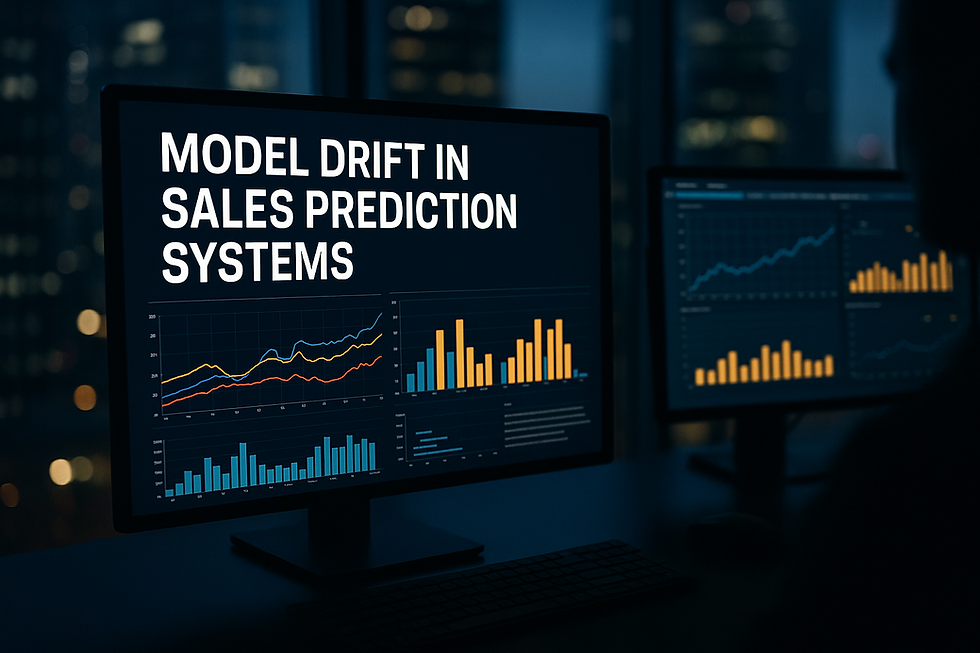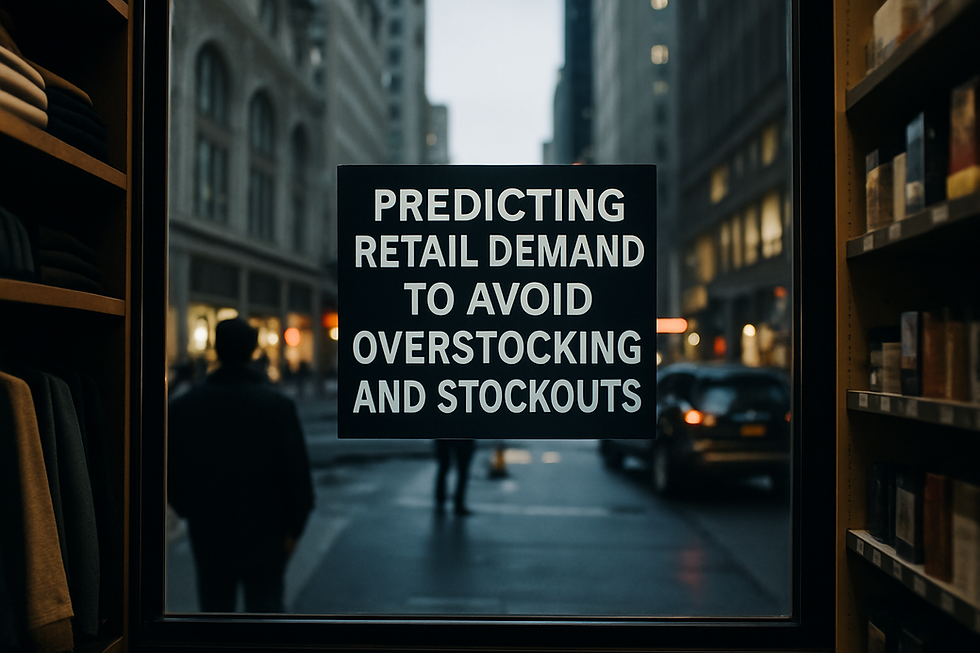Reducing Model Drift in Sales Prediction Systems
- Muiz As-Siddeeqi

- Aug 20
- 5 min read

When the Model Lies and the Market Moves: A Reality Check
You built it. You trained it. You launched it.
Your predictive model for sales forecasts once worked like magic — it could practically smell the next big deal in the pipeline before your reps even knew who they were selling to.
But now?
Now, it’s guessing. Blindly. Sales projections are suddenly missing the mark. Recommendations feel off. Conversion rates are slipping, and the model that once boosted your bottom line is now silently sabotaging it.
This isn’t a bug. This isn’t a glitch.
This is model drift in sales prediction systems — and if you're not actively reducing it, you're putting millions of dollars, thousands of hours, and your entire data science credibility on the line.
And that’s not drama. That’s documented.
Bonus: Machine Learning in Sales: The Ultimate Guide to Transforming Revenue with Real-Time Intelligence
The Silent Killer of Machine Learning in Sales
Model drift is when your once-accurate machine learning model starts degrading over time because the real-world data it sees changes — but the model doesn’t. The inputs evolve, user behavior shifts, market dynamics transform… but the model? It’s stuck in the past.
In sales, this is catastrophic.
Your seasonality patterns may change due to new product launches or competitor shifts.
Buyer personas morph as industries digitize.
Macroeconomic shocks (like COVID-19 or interest rate hikes) completely restructure demand behavior.
And the worst part?
You might not notice model drift until after it has silently chewed through your last two quarters.
How Bad Is It? The Brutal Truth, Backed by Numbers
The global ML market is exploding — expected to surpass $528 billion by 2030 (Statista, 2024). Yet, according to the State of AI in the Enterprise Report by Deloitte (2023):
❝ 39% of companies reported model degradation or drift as one of the top 3 operational risks in their AI systems. ❞
In a separate study by Evidently AI (2023):
❝ 84% of production ML models show signs of drift within six months of deployment in dynamic sectors like sales, e-commerce, and digital marketing. ❞
That means if you deployed your predictive model this January, there’s a very good chance it’s already lying to you by July.
And if you're not monitoring drift actively?
You might be building your sales strategy on quicksand.
Not All Drift Is Created Equal: The 3 Types That Haunt Sales Systems
Let’s cut through the jargon and talk real-world, real-pain types of model drift that wreck sales predictions:
1. Data Drift (Covariate Shift)
This happens when the input data distribution changes.
Maybe your leads used to come from LinkedIn, but now they’re flooding in from TikTok ads.
Maybe your pricing structure changed.
Maybe a new CRM field was introduced, and it’s skewing inputs.
🡒 Your model is reading a different language now, but it still thinks it’s English.
2. Concept Drift
This is the killer.
The underlying relationship between inputs and outputs changes. That means the same behavior no longer leads to the same outcome.
A cold email that once guaranteed a reply now gets ghosted.
A product demo used to be a conversion booster. Now it’s not moving the needle.
🡒 The rules of the game changed, but your model didn’t get the memo.
3. Label Drift
Yes, even your ground truth can betray you.
In sales, this could be:
Changing definitions of what counts as a “qualified lead.”
Internal realignment on what counts as a “sale.”
🡒 You’re training on shifting sands.
Real Case: Expedia Group vs Concept Drift
In 2021, Expedia Group revealed in a KubeCon talk that their ML models for user engagement and booking behavior were suffering from severe performance decay due to concept drift post-COVID-19.
Travel patterns changed.
Booking windows shortened drastically.
User behavior under lockdown was completely different.
They had to re-architect their model monitoring pipeline to include drift detection and retraining triggers, else millions of dollars would have been misallocated in misjudged campaigns.
Source: Expedia Group's public KubeCon 2021 session.
The Hidden Costs of Ignoring Drift in Sales Predictions
If you think model drift is just about lower accuracy metrics, think again.
It leads to:
Missed forecasts → Finance loses trust in data science
Wasted ad spend → Marketing burns budget on wrong segments
Wrong prioritization → Sales reps chase the wrong leads
Customer churn → Predictive signals miss early warning signs
A 2023 report by McKinsey found that:
❝ Companies that failed to detect ML model drift in core operational models experienced forecasting errors 22% higher on average than those that had active drift monitoring in place. ❞
Now What? The Real-World Playbook to Reduce Model Drift in Sales Prediction Systems
Step 1: Monitor Everything. Assume Nothing.
Start with:
Feature distribution monitoring (using tools like EvidentlyAI, WhyLabs, or Arize AI)
Prediction score shifts (track average prediction confidence over time)
Segment-level performance (is your model still working well on SMB vs Enterprise leads?)
🡒 Set up alerts. Don’t rely on “gut feel.”
Step 2: Log. Everything.
Don’t just monitor — log historical performance.
Track AUC, precision, recall, etc. weekly
Maintain logs of external events (product launches, pricing changes, market shifts)
It’ll help you trace the root cause of drift when it happens.
Step 3: Retrain with Strategy, Not Panic
Don’t just retrain weekly for the sake of it. Do it when it matters:
Data volume thresholds met
Performance dip crosses alert line
Concept shifts detected
Retraining costs time and compute — be surgical, not spammy.
Step 4: Embrace Adaptive Models
Several cutting-edge organizations use online learning or rolling-window training to deal with drift dynamically.
Examples:
Spotify retrains some user models nightly.
Uber uses streaming data pipelines to keep models fresh.
For sales, consider rolling 3-month data windows for training so that your model always learns from recent behaviors.
Step 5: Stay Context-Aware
Add context features like:
Date-based features (seasonality)
Campaign type (to isolate performance differences)
Macroeconomic signals (to understand demand-side changes)
This allows your model to be aware of time and change — reducing blind spots.
Real Tools Being Used in Production (2024–2025)
Here are non-fictional, in-production tools and platforms being used to fight drift in sales ML systems:
Evidently AI – Open-source drift detection and performance monitoring tool
Arize AI – ML observability platform used by Chime, Etsy, and Hopin
WhyLabs – Data and model monitoring with anomaly detection
Fiddler AI – Explainability and monitoring (used by Intuit and Prosus)
Source: Company documentation and case studies from TechCrunch, AWS re:Invent, and Arize/WhyLabs webinars
The Billion-Dollar Lesson: Don’t Just Build, Maintain
It’s easy to launch an ML model.
But real impact lives in maintenance.
Just like a high-performance car needs tune-ups and oil changes, your sales prediction system needs:
Regular drift detection
Controlled retraining
Real-world alignment
Or else?
Your “AI-powered sales engine” becomes a hallucinating guess machine.
Final Words From The Field
When companies like Uber, Netflix, Etsy, and Expedia — giants with elite ML talent — publicly admit to battling model drift...
…what chance does a small to mid-sized sales operation have if they ignore it?
Sales is volatile. Markets change fast. Buyer intent shifts overnight.
Model drift isn’t a maybe. It’s a guarantee.
Your job isn’t to avoid it — your job is to detect it, understand it, and defeat it.
And if you can do that?
Your predictive sales engine won’t just survive change.
It’ll thrive because of it.

$50
Product Title
Product Details goes here with the simple product description and more information can be seen by clicking the see more button. Product Details goes here with the simple product description and more information can be seen by clicking the see more button

$50
Product Title
Product Details goes here with the simple product description and more information can be seen by clicking the see more button. Product Details goes here with the simple product description and more information can be seen by clicking the see more button.

$50
Product Title
Product Details goes here with the simple product description and more information can be seen by clicking the see more button. Product Details goes here with the simple product description and more information can be seen by clicking the see more button.






Comments